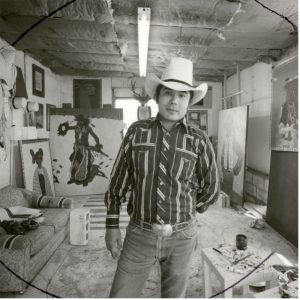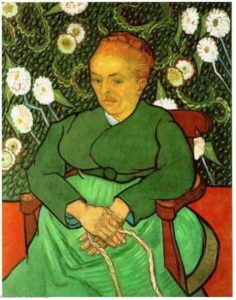by Dewyne Matthews
These notes reflect my own ideas and understanding and not those of the Heard Museum or Guild. Please let me know immediately of any errors or misconceptions you see, plus any corrections, suggestions, additional information or insights you can share.
Who was TC Cannon?
Tommy Wayne (TC) Cannon was a Kiowa/Caddo artist born in rural Oklahoma. His artistic talent was recognized as a child and upon graduation from high school in 1964, he enrolled in the then-new Institute of American Indian Arts (IAIA) in Santa Fe. With teachers like Fritz Scholder and fellow students including Doug Hyde, Earl Biss, and Kevin Red Star, IAIA in the 1960s was reinventing and redefining Native art. After graduating from IAIA—then a two-year college—Cannon enlisted in the US Army and served in Vietnam, earning two Bronze Stars. He lived and worked in Santa Fe until dying in an automobile accident in 1978 at the age of 31.
What is Cannon’s legacy?
Cannon rejected the limitations imposed on Native artists, saying “I am tired of Bambi-like deer paintings reproduced over and over—and I am tired of cartoon paintings of my people.” But he also studied and embraced Western artists like Van Gogh and Matisse and was unafraid to show that influence in his work. The result was work of uncommon power and beauty.
What are the works in this exhibit?
Five of these works—all except for the painting Moon and Stars over Taos—are woodblock prints of larger paintings done later in Cannon’s career. They were made by Cannon in collaboration with two master Japanese printmakers, and the colors and metallic inks make the prints extraordinarily vibrant. Most juxtapose their Native subjects with obviously non-Native settings and adornments. The figures in several of these works were derived from staged 19th century photographs of Native people. In Collector #5, a figure derived from a 1858 photo of Chief Petalesharo of the Skidi Pawnee Nation is sitting in a wicker chair placed on a Navajo textile with a Van Gogh painting over his shoulder. In Two Guns Arikara (Arikara is the name of a tribe from North Dakota), the subject is wearing a combination of traditional regalia and a cavalry uniform in an ornate Victorian-style sitting room and is holding two pistols casually across his lap. The stern expressions on both faces confront the viewer.
The painting style and color is obviously influenced by Van Gogh and Matisse, but there is no mistaking that the intent of the work is to explore themes of oppression, displacement, and Native identity. It is perhaps that dichotomy that makes Cannon’s work so fascinating and relevant.
An Indian painting is any painting that’s done by an Indian. Today, however, I really don’t think there is such a thing as an “Indian painting.” There are so many modes that people are working in that it seems beside the point to call a painting Indian just because the artist is an Indian. People don’t call a work by Picasso a Spanish painting. After all, Picasso spent most of his life in France anyway. Does that make him a Spanish painter or a French painter? I say it makes him Picasso.”

